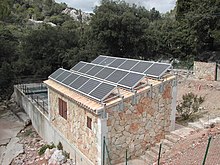Island system
Island systems , network-independent , self-sufficient , island systems or off-grid systems usually refer to systems for supplying electrical energy and are permanently installed or mobile systems that are implemented without being connected to a nationwide public power grid . They are used where connection to the power grid is not possible or not economical. Their operation is called island operation . Smaller power grids, which consist of one or a few power plants and which are larger in scope, are referred to as island grids .
Although every system that is supplied with energy on its own is in island mode, this term is not used in the on- board network of means of transport. With these, however, as with systems with a grid connection, island operation can occasionally occur if an auxiliary energy source is available for a longer standstill for a longer power failure .
In areas with a dense, reliable power grid, such as most of Europe, island systems are mostly technical devices with low power consumption, where cabling would be more complex than self-supply, for example with solar modules . Examples of this are parking ticket machines , pasture fences or toll control bridges.
Buildings can also be operated in the form of an island system. An energy self-sufficient building is designed without a connection to the public electricity or gas network and does not use any other energy sources such as B. Wood as a solid fuel. All the energy required for operation is produced on the property of the building. In contrast to this, a zero-energy house or a plus-energy house typically produces as much energy as was consumed or more over a period of typically one year.
Energy sources
Systems with internal combustion engines
When there is a greater demand for electricity, generators coupled with diesel engines and , more rarely, gasoline engines (also biogas-operated) are used, which supply the national mains voltages and are referred to as a power generator . Diesel gensets or permanently installed diesel power plants are not particularly durable (1 to 2 years until the engine is overhauled) and are less efficient (approx. 30%) than coal-fired power plants even at high levels of utilization. Application examples for this are, in addition to remote small settlements, also large events with high electricity requirements or remote petrol stations. For firefighters , THW and Bundeswehr also diesel engines are used.
In order to guarantee a supply of devices designed for mains alternating voltage, a reasonably constant mains frequency of 50 Hz or 60 Hertz is necessary even with stand-alone systems . This is ensured by regulating the speed of the generator or, in the case of direct current sources ( solar modules , accumulators), by the inverter used .
Compared to gas turbines, for example, diesel gensets are characterized by an efficiency that does not fluctuate with the power generated.
Renewable Energies
In areas remote from the existing supply infrastructure, the costs for the infrastructure to be created (electrical networks, gas network, ...) make up an increasing proportion of the costs of energy supply. These include B. also the transport of fuels to mountain huts or the connection of navigation signs to an electrical energy supply.
Falling system prices make decentralized renewable energy sources in particular more economical. The choice depends on the current supply and the respective load profile - hydropower for some mountain huts, wave energy for a sea mark, wind generator for the sailing yacht, solar modules for the mobile home. Different types of storage such as accumulators , heat storage, etc. can be used to bridge periods of low yield . If several producers are used for the supply, one speaks of a hybrid system. Project developers specializing in renewable energies offer solutions for supplying areas not connected to a grid by means of a combination of several technologies and storage facilities.
On the consumer side, it can make sense to purchase more economical devices that can use the battery voltage of the stand-alone grid directly on the DC side. Sometimes it is possible to simply bypass a power supply unit, for example with a notebook, in order to avoid double losses, first in the inverter , then in the power supply unit. Direct heat in the form of electrical heat is very inefficient in terms of energy and therefore usually does not make sense.
Connection and tariff conditions of the energy suppliers can contractually restrict a permanent connection between an in-house island network and the normal electricity network.
Others
Isotope batteries are used to supply remote, unmanned weather stations, radio beacons and some spacecraft . Often these also serve for heating. They have a low level of efficiency, but decades of maintenance-free operation. The installed electrical power ranges from a few watts to a few hundred watts.
literature
- Philipp Brückmann: Autonomous power supply: Design and practice of power supply systems with battery storage . 2nd edition, Ökobuch, Staufen near Freiburg 2007, ISBN 978-3-936896-28-2 .
- Heinrich Häberlin: Photovoltaics: Electricity from sunlight for network and island systems . 2nd edition, Electrosuisse , Fehraltorf / VDE , Berlin 2010, ISBN 978-3-905214-62-8 (Electrosuisse) / ISBN 978-3-8007-3205-0 .
- John K. Kaldellis, et al .: Stand-Alone and Hybrid Wind Energy Systems - Technology, Energy Storage and Applications. Woodhead Publishing, Cambridge 2010, ISBN 978-1-8456-9527-9 .
Web links
- Photovoltaic island systems in traffic (PDF; 17 kB)
- Calculation tool for stand-alone PV systems (pro-umwelt.de)
- Calculation tool for stand-alone PV systems (esomatic.de)
- Calculation example of energy consumption with self-sufficient power supply systems (Solar-und-Windenergie.de)
Individual evidence
- ↑ Off-Grid - Supply your energy island with renewables , website of ABO Wind AG. Retrieved August 25, 2017.

